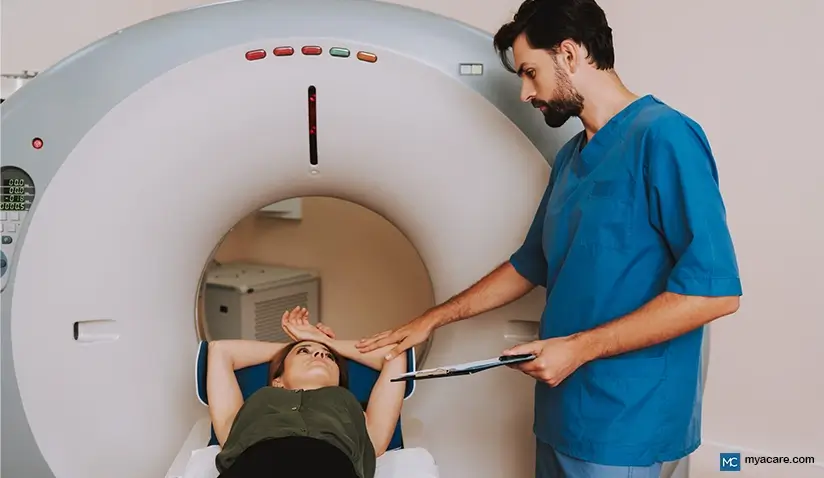Should CT Scans Be Done for Head Injuries?

Head injuries are common, with many cases due to an accident. Different imaging methods are available, but CT scans are usually the best option for people with head injuries. However, the safety of CT scans for individuals on blood thinners is a cause for concern. Read on to learn more about CT scans for head injuries and if taking blood thinners impacts the use of CT imaging.
How Does a CT Scan Work?
A CT (computerized tomography) scan is an imaging method that works by creating cross-sectional visual image slices of the body. These sliced images are then combined to produce a 3D view of the body. In fact, a CT scan provides a more detailed view of the insides than an X-ray.
CT Scans and Contrast
CT scans can sometimes utilize contrast. This is when you are injected with a dye before the procedure for better visibility of specific structures. This is sometimes done in head CTs when blood vessels require visualization in greater detail.
CT Scans and Head Injuries
A CT scan is usually performed when a person has a head injury. Different types of trauma can cause brain injuries, such as a car accident or a blow to the head. For instance, a blow to the head can cause a concussion due to a rapid movement of the head and brain. A concussion can be mild or severe.
A person with a severe head injury should undergo imaging such as a CT scan to check for bleeding or other brain injuries.
In addition, some symptoms may indicate a brain injury and the need for a CT scan. These signs and factors are as follows:
- Loss of consciousness
- Vomiting
- Alcohol intoxication
- Amnesia
Sometimes a person who has not been in an accident can have symptoms that indicate a possible brain problem. Imaging tests such as CT and MRI may be prescribed for symptoms such as severe headache and seizures. These tests can reveal anatomical anomalies in the brain that could be causing the symptoms.
Types of Head Injuries a CT Scan Can Detect
CT scans can detect several brain injuries. These are listed and described below.
- Stroke: a stroke is also known as a cerebrovascular accident (CVA), and it can be ischemic (when oxygen is cut off due to a blood clot) or hemorrhagic (from a bleed in the brain).
- Aneurysm: a swelling in a blood vessel.
- Tumor: an abnormal mass in the brain, which can be benign or cancerous. One of the more common types of cancerous brain tumors is glioma. Sometimes brain cancer can be managed with surgery.
- Brain swelling: a CT scan can reveal swelling in the brain. Swelling is dangerous because there is limited space inside the head for the brain tissue to expand.
- Brain contusions: this is when the brain is bruised.
- Subdural hematoma: a collection of blood that occurs between the dura mater membrane and the brain.
- Subarachnoid hemorrhage: active bleeding between the brain and the arachnoid membrane of the brain.
Hematomas and hemorrhages in the brain are dangerous and often require surgery to remove pooled blood or to stop active bleeding.
Major ead injuries and how they may present
Major injuries, such as a traumatic brain injury (TBI), usually require imaging such as CT to evaluate if a patient requires brain surgery. These signs include:
- The presence of a skull fracture: this shows significant head trauma.
- Glasgow coma scale (GCS) of less than 13: this scale indicates the level of consciousness and responsiveness in a patient. A low GSC score can indicate significant brain damage.
- Vomiting and head pain: Vomiting and headache indicate a likely problem with the brain. These symptoms often appear in cases of concussion.
- Age over 65: Older Adults are at higher risk of brain injury.
- Infants: Babies are at high risk of brain injury.
Minor head injuries and what to watch for
A person with a minor head injury may not show any initial signs of anything being wrong. Therefore, it is essential to watch for the symptoms discussed below carefully.
- Visual problems such as blurred vision or one pupil being larger than the other
- A very bad headache where a person may state this is the worst headache they have ever had; this is often a sign that there is a serious problem in the brain, such as a bleed
- The person is unusually sleepy and is hard to awaken
- Strange changes in behavior such as aggression or irritability
- Vomiting and nausea
- Convulsions
- Loss of sensation on one side of the body or in a limb
- Watery or bloody secretion from the ears or the nose
- Unusual breathing
- A fast or slow pulse
A person showing any of the abovementioned signs after a head injury should be taken to a doctor immediately.
CT Ccans and Blood Thinners
Blood thinners are known as anticoagulant medications because they hinder the blood's ability to clot. A few common examples of anticoagulants are aspirin, heparin, and warfarin.
For routine CT studies, when a person has not been in an accident, the patient is usually told to refrain from taking anticoagulants a few days before the CT scan.
There is an increased risk of a brain bleed after an accident in patients on blood thinners, but the question is whether a CT scan is always a good idea. Some scientists recommend initial checks for other risk factors, such as loss of consciousness, while others recommend completing an initial CT scan.
Even if none of the factors, such as loss of consciousness, headache, or vomiting, are present, a follow-up CT scan should be completed a few hours later for people on anticoagulants. This is because there can be a delayed response to head trauma.
Conclusion
A CT scan is an imaging method often advisable after a head injury. There are certain signs to watch for that may indicate a significant head injury. People on blood thinners are at particular risk for bleeding in the brain after head trauma. If unsure, it is best to check with a doctor if a head injury is suspected.
To search for the best doctors and healthcare providers worldwide, please use the Mya Care search engine.

Dr. Rae Osborn has a Ph.D. in Biology from the University of Texas at Arlington. She was a tenured Associate Professor of Biology at Northwestern State University, where she taught many courses to Pre-nursing and Pre-medical students. She has written extensively on medical conditions and healthy lifestyle topics, including nutrition. She is from South Africa but lived and taught in the United States for 18 years.
Sources:
Featured Blogs



